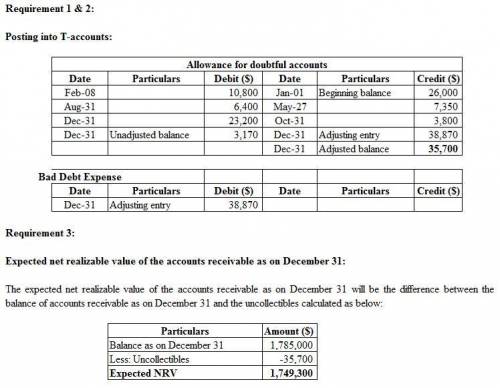
Business, 11.04.2020 04:50 BreadOfTheBear
The following transactions were completed by The Irvine Company during the current fiscal year ended December 31: Feb. 8 Received 40% of the $18,000 balance owed by DeCoy Co., a bankrupt business, and wrote off the remainder as uncollectible. May 27 Reinstated the account of Seth Nelsen, which had been written off in the preceding year as uncollectible. Journalized the receipt of $7,350 cash in full payment of Seth’s account. Aug. 13 Wrote off the $6,400 balance owed by Kat Tracks Co., which has no assets. Oct. 31 Reinstated the account of Crawford Co., which had been written off in the preceding year as uncollectible. Journalized the receipt of $3,880 cash in full payment of the account. Dec. 31 Wrote off the following accounts as uncollectible (compound entry): Newbauer Co., $7,190; Bonneville Co., $5,500; Crow Distributors, $9,400; Fiber Optics, $1,110. Dec. 31 Based on an analysis of the $1,785,000 of accounts receivable, it was estimated that $35,700 will be uncollectible. Journalized the adjusting entry. Required: 1. Record the January 1 credit balance of $26,000 in a T account for Allowance for Doubtful Accounts. 2. A. Journalize the transactions. For the December 31 adjusting entry, assume the $1,785,000 balance in accounts receivable reflects the adjustments made during the year. Refer to the chart of accounts for a listing of the account titles the company uses. B. Post each entry that affects the following selected T accounts and determine the new balances: Allowance for Doubtful Accounts and Bad Debt Expense. 3. Determine the expected net realizable value of the accounts receivable as of December 31 (after all of the adjustments and the adjusting entry). 4. Assuming that instead of basing the provision for uncollectible accounts on an analysis of receivables, the adjusting entry on December 31 had been based on an estimated expense of ¼ of 1% of the net sales of $18,200,000 for the year, determine the following: A. Bad debt expense for the year. B. Balance in the allowance account after the adjustment of December 31. C. Expected net realizable value of the accounts receivable as of December 31.
1. Record the January 1 credit balance of $26,000 in a T account for Allowance for Doubtful Accounts.
2.
B. Post each entry that affects the following selected T accounts and determine the new balances: Allowance for Doubtful Accounts and Bad Debt Expense.
Allowance for Doubtful Accounts
Feb. 8 Jan. 1 Balance
Aug. 13 May 27
Dec. 31 Oct. 31
Dec. 31 Adjusting Entry
Dec. 31 Unadjusted Balance Dec. 31 Adj. Balance
Bad Debt Expense
Dec. 31 Adjusting Entry
Points:
0.44 / 1
Feedback
Check My Work
Set up T accounts.
Journal
Shaded cells have feedback.

Answers: 2


Other questions on the subject: Business

Business, 21.06.2019 19:30, qwertylol12345
Vulcan company is a monthly depositor whose tax liability for march 2019 is $2,510. 1. what is the due date for the deposit of these taxes? march 17 2. assume that no deposit was made until april 29. compute the following penalties. assume a 365-day year in your computations. round your answers to the nearest cent. a. penalty for failure to make timely deposits. $ b. penalty for failure to fully pay employment taxes $ c. interest on late payment (assume a 5% interest rate). $ d. total penalty imposed $
Answers: 3

Business, 22.06.2019 04:00, tmcdowell69
Don’t give me to many notifications because it will cause you to lose alot of points
Answers: 1

Business, 22.06.2019 17:30, gabedafame26
Palmer frosted flakes company offers its customers a pottery cereal bowl if they send in 3 boxtops from palmer frosted flakes boxes and $1. the company estimates that 60% of the boxtops will be redeemed. in 2012, the company sold 675,000 boxes of frosted flakes and customers redeemed 330,000 boxtops receiving 110,000 bowls. if the bowls cost palmer company $3 each, how much liability for outstanding premiums should be recorded at the end of 2012?
Answers: 2

Business, 22.06.2019 18:30, spazzinchicago
Health insurance protects you if you experience any of the following except: a: if you have to be hospitalized b: if you damage someone's property c: if you need to visit a clinic d: if you can't work because of illness
Answers: 2
You know the right answer?
The following transactions were completed by The Irvine Company during the current fiscal year ended...
Questions in other subjects:

Biology, 25.06.2021 21:50





Mathematics, 25.06.2021 21:50

Mathematics, 25.06.2021 21:50








